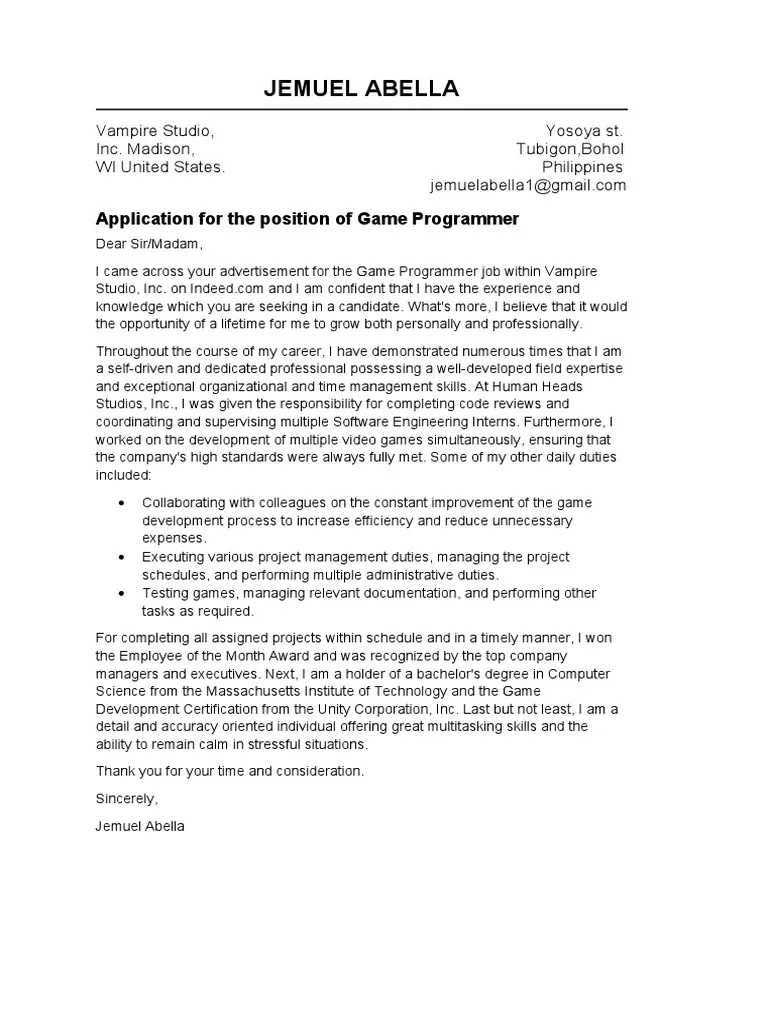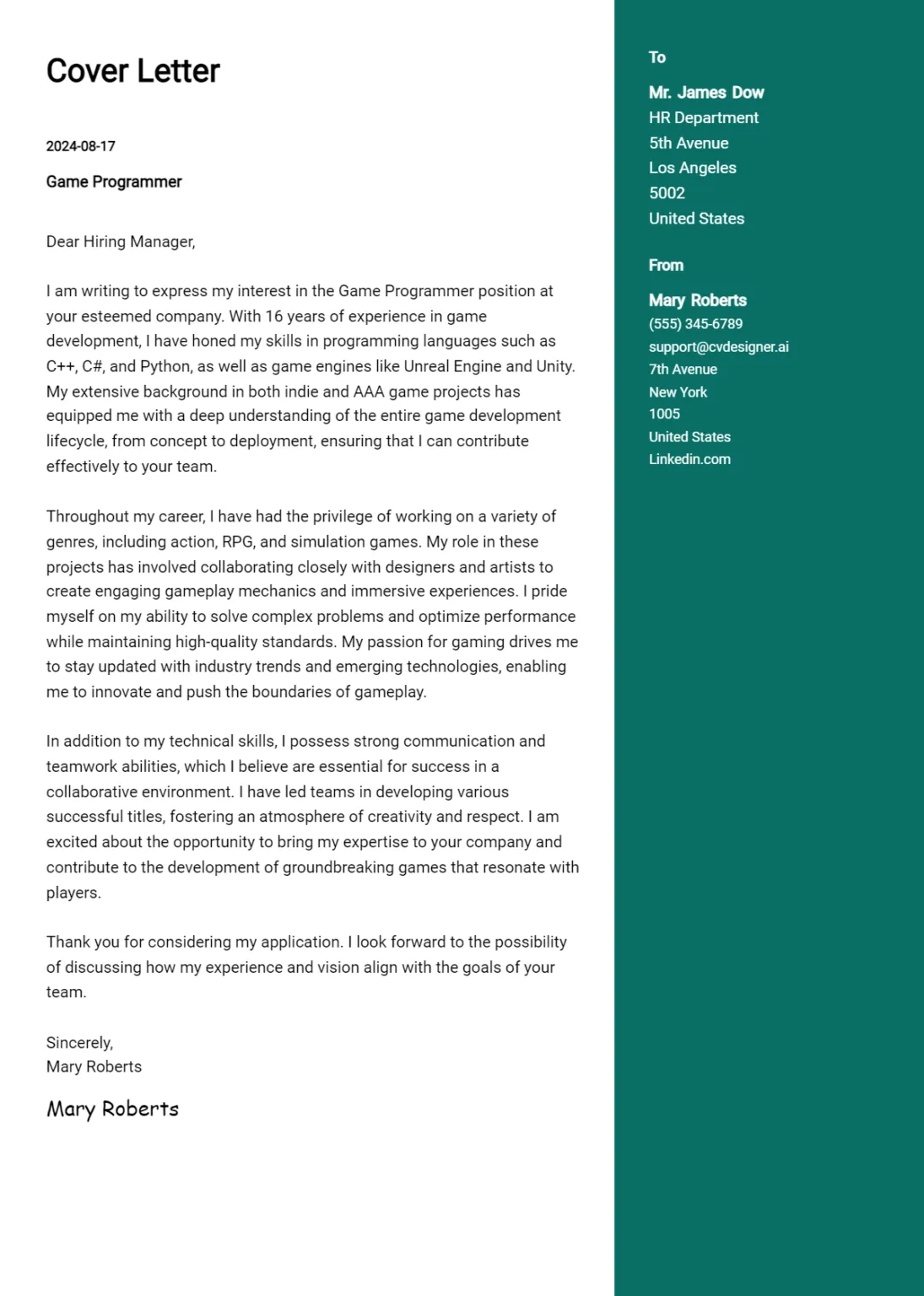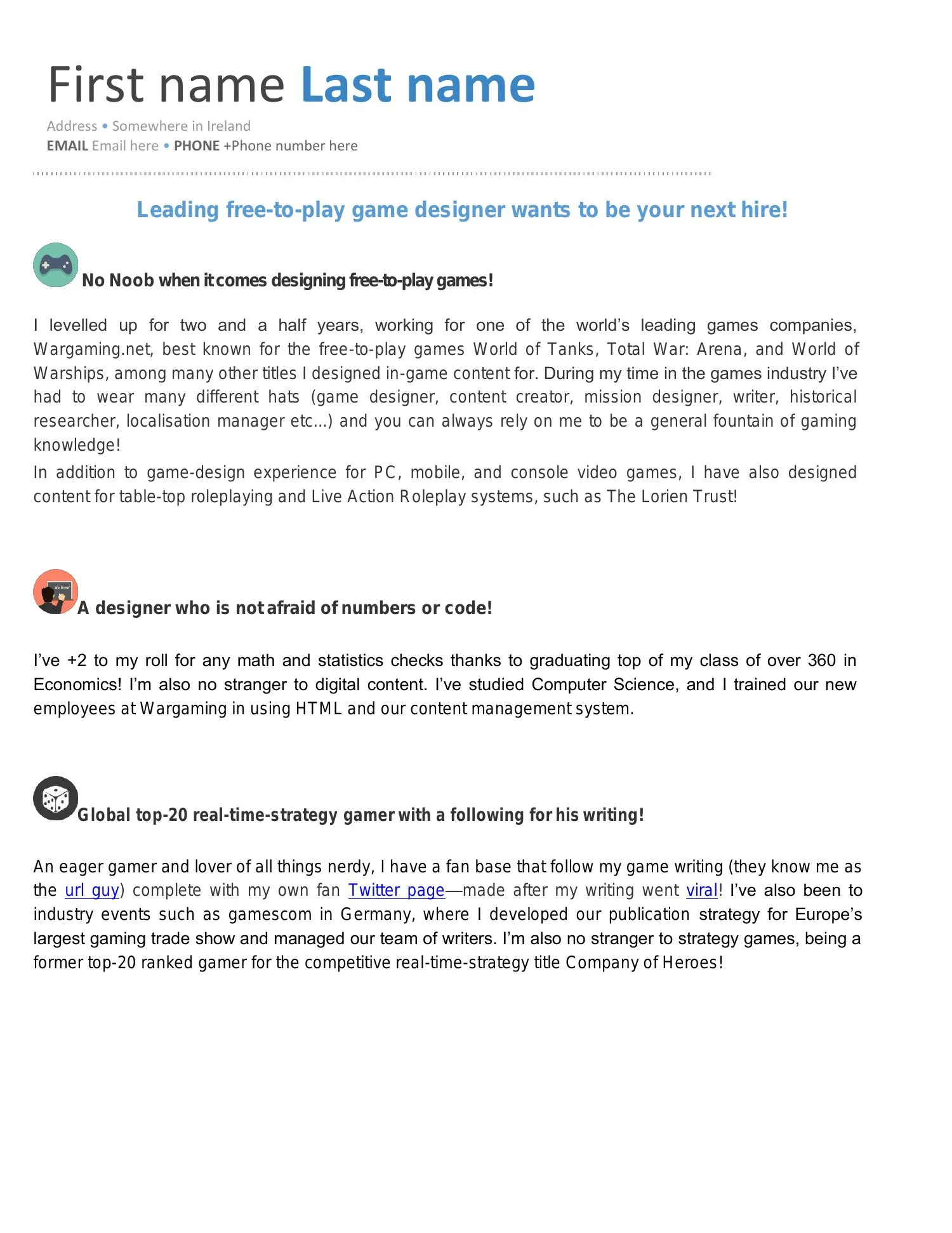Why a Cover Letter Is Crucial for Game Designers
In the competitive world of game design, a cover letter is your first opportunity to make a positive impression. While a resume provides a snapshot of your skills and experience, a cover letter allows you to showcase your personality, passion, and unique perspective. It’s a chance to tell your story and explain why you’re the perfect fit for the role. Without a cover letter, you might be perceived as just another applicant, but with a well-crafted one, you can immediately set yourself apart from the competition. A strong cover letter demonstrates your communication skills, attention to detail, and genuine interest in the specific company and position, making it a vital component of any successful job application. Remember, it’s often the cover letter that convinces a hiring manager to delve deeper into your qualifications.
Highlighting Your Game Design Skills
Your cover letter is the ideal space to explicitly detail the skills that make you a proficient game designer. Be specific and avoid generic statements. Instead of merely saying you possess ‘design skills,’ list particular skills like level design, character design, UI/UX design, or experience with specific game engines like Unity or Unreal Engine. Quantify your accomplishments whenever possible; for instance, ‘designed and implemented 10+ levels’ or ‘reduced player tutorial time by 15% through UI improvements.’ Tailor this section to align with the job description, highlighting the skills most relevant to the role. Demonstrate that you understand the demands of the position and have the expertise to contribute meaningfully to the team and project, showing concrete evidence of your abilities and experiences, to catch the hiring manager’s eyes immediately.
Showcasing Your Portfolio

A game designer’s portfolio is as crucial as a painter’s canvas. Your cover letter should guide the hiring manager directly to your best work. Clearly mention your portfolio and provide a link to it, ensuring it’s easily accessible and well-organized. Highlight specific projects that are most relevant to the job you’re applying for. Instead of simply stating, ‘See my portfolio,’ briefly describe a few key projects and the specific design challenges you overcame. Mention the game’s genre, your role, and what you consider to be the project’s greatest achievements. This gives the hiring manager a preview and encourages them to explore your portfolio further, showing them immediately what you’re capable of and giving them a taste of your unique design style, thus piquing their interest.
Tailoring Your Cover Letter
Generic cover letters often end up in the trash. Customize each cover letter to fit the specific company and role. Research the company, understand their games, and identify what makes their work unique. In your cover letter, demonstrate that you understand their values and what they’re looking for in a designer. Mention specific projects, technologies, or design philosophies that resonate with you and the company. Explain why you’re excited about the particular opportunity and how your skills align with their needs. Personalize your letter by referencing something specific about the company or the team, showing that you’ve invested time and effort. This level of customization shows genuine interest and significantly increases your chances of getting noticed, showing that you are a perfect fit and that you’re not just spamming applications.
The Importance of Keywords
Many companies use Applicant Tracking Systems (ATS) to scan applications for relevant keywords. To ensure your cover letter gets past the initial screening, carefully review the job description and incorporate the keywords into your letter. Identify the skills, software, and experience that the employer is looking for and include them naturally within your text. However, avoid keyword stuffing, which can make your letter sound unnatural and detract from its effectiveness. The goal is to demonstrate that your skills and experience align with the job requirements, so it’s important to use keywords genuinely and strategically. This tactic helps your application reach the hiring manager and shows you understand the role’s requirements. This strategy ensures that your application gets the attention it deserves, increasing your chances of securing an interview.
Demonstrating Your Passion

Game design is a field driven by passion. Let your enthusiasm for games shine through in your cover letter. Describe what you love about game design, why you’re drawn to the industry, and what motivates you to create immersive and engaging experiences. Share your excitement for the company’s games or projects. Mention a particular game that inspired you or a design trend you find fascinating. Show that you’re not just looking for a job but that you are genuinely excited to contribute to the world of game design. This passion often outweighs the need for experience. Conveying your enthusiasm will make your application memorable and position you as a highly motivated and enthusiastic candidate, significantly boosting your chances of success.
Proofreading and Editing
A cover letter riddled with errors can immediately disqualify you. Before submitting your application, carefully proofread your cover letter for any grammatical errors, typos, or awkward phrasing. Read it aloud to catch any sentences that sound unclear or disjointed. Consider asking a friend or colleague to review your letter. They might catch mistakes you’ve overlooked. Ensure that your tone is professional, your grammar is impeccable, and your message is clear and concise. The quality of your cover letter reflects the attention to detail you’ll bring to your design work. A well-written, error-free cover letter shows respect for the hiring manager’s time and attention to detail, which is an essential skill for a game designer.
Following Up
After submitting your application, don’t be afraid to follow up. A week or two after applying, send a polite email to the hiring manager or recruiter, reiterating your interest and briefly reminding them of your qualifications. This shows your continued interest and initiative. If you haven’t heard back within a reasonable timeframe, it might be appropriate to follow up again. Ensure your communication is professional, concise, and reiterates your enthusiasm for the role. Following up can remind the hiring manager of your application and demonstrate your proactive approach. Following up can distinguish you from other applicants and shows your strong interest in the position, which enhances your chance of being considered for the role.
Formatting Your Cover Letter

Contact Information
Start with your contact information at the top of your cover letter. Include your full name, phone number, email address, and a link to your professional online portfolio or website. Make it easy for the hiring manager to reach you. Ensure your contact information is current and professional. This simple step makes the process of contacting you seamless and professional, displaying your attention to detail and your commitment to being accessible for further discussion. Make sure your contact information is easily accessible and correct.
Addressing the Hiring Manager
Always address your cover letter to the hiring manager or the specific person responsible for the role if possible. Research the company to find the correct name. If you can’t find a specific name, use a general greeting like ‘Dear Hiring Manager’ or ‘Dear [Company Name] Team’. Avoid generic greetings like ‘To Whom It May Concern.’ Addressing the letter personally adds a touch of professionalism and shows you’ve taken the time to learn about the company. Addressing the person correctly makes it clear that you have personalized your application and are eager to connect with them, showing your dedication and thoroughness.
Structuring Your Letter

Structure your cover letter logically. Start with a compelling opening that grabs the reader’s attention and states the position you are applying for. The body of your letter should highlight your relevant skills and experience, showcasing why you’re a great fit for the role. Use clear, concise language and break up the text with short paragraphs. Finish with a strong closing, reiterating your interest and thanking the hiring manager for their time and consideration. Keep your cover letter concise, aiming for no more than one page. This structured approach makes your letter easy to read and increases the chances of the hiring manager reading it thoroughly.
Actionable Advice: Write a Cover Letter That Works
Writing a compelling cover letter is an essential skill for any game designer. By following these seven tips – highlighting your skills, showcasing your portfolio, tailoring your letter, using keywords, demonstrating passion, proofreading, and following up – you can significantly increase your chances of landing your dream job. Remember to always tailor each letter to the specific role and company. Take the time to research the company, understand their needs, and explain how your skills and experience align with their goals. A well-crafted cover letter, combined with a strong resume and portfolio, can set you apart from the competition. Approach your cover letter as a chance to tell your story, demonstrate your enthusiasm, and show why you are the perfect candidate. By applying these strategies, you’ll be well on your way to impressing hiring managers and securing your next game design opportunity.
